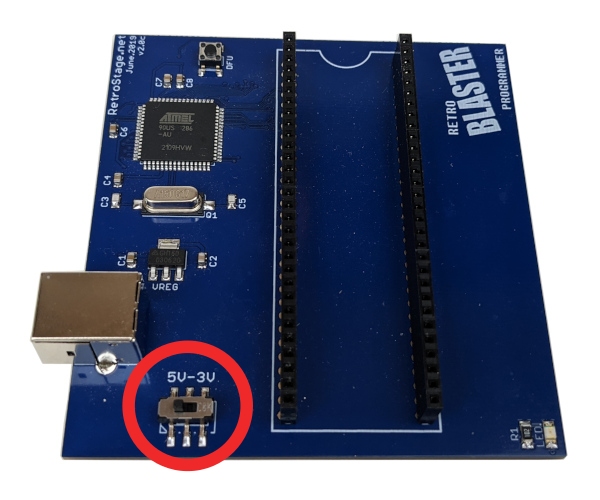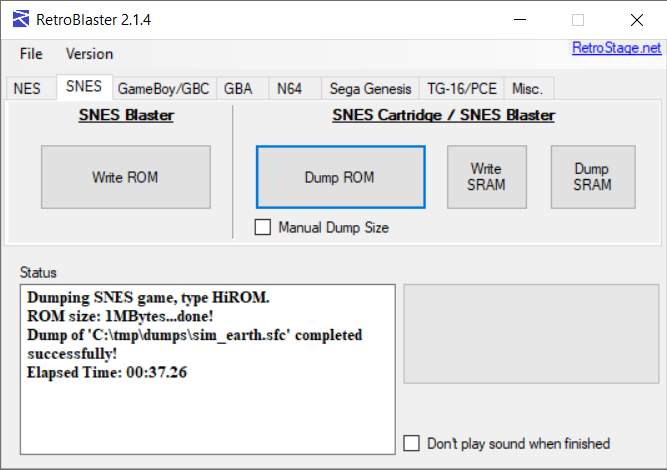Super Nintendo Entertainment System / Super Famicom
Introduction
Dumping SNES / SFC cartridges require the use of a specialized dumper hardware that supports the cartridges, not to mention these dumpers may not be able to dump every single kind of cartridges.
Cartridges that contain the SA-1 Chip may not able to work because of its anti-piracy measures, be sure to read about the methods that support it.
Some cartridges may also be not supported because of its memory mapping like Sufami Turbo and Satellaview compatible cartridges (like BS-X), or like game prototypes that don't contain proper info about the cartridge itself.
If you need help, please come chat with us on the VGPC or No-Intro discord servers.
Important Notes
- Unopened games should have their ROM and save data dumped before attempting to play them. This avoids inadvertent modification of the data and helps preserve any possible rewritable data in its unused/“factory” state. This is especially important for types of cart that store the ROM on rewritable media, or games that come with special save data pre-installed. But it is not necessarily possible to know in advance, hence why its advisable to dump first. Note in your submission whether the physical media was sealed and include a photo of the cart/packaging in its sealed state, if possible.
- You should clean the physical media's physical contacts (e.g. electrical contacts for carts/reflective surface for discs) before trying to dump it, then dump it, and if it doesn't match something in the database, clean it again and dump it a second time, checking if both dumps match using a file comparison tool or calculating the SHA256 of each file and comparing those values. This helps ensure that dirt on the contacts is not causing interference, and that dirt was fully removed during the cleaning process.
- Especially for rare items, make sure to keep the media and dumping hardware around as long as possible (and keep in contact with any future owner if possible), in case an issue with the dump comes up. At minimum (again, if possible) its good idea to keep it around for a while after its been added to the database.
Methods
Open Source Cartridge Reader
The Open Source Cartridge Reader (OSCR) is an open source Arduino based dumper that supports several systems, including SNES. It is portable, can be customized and does not need a computer to work.
Only a SD card is needed. Follow the flashing instructions to update the firmware of your Cart Reader.
If the OSCR is equipped with a snesCIC and Adafruit Clock Generator, it is possible to dump cartridges with embedded SA-1 chip.
Dumping Regular Cartridges
- Unplug the power from the hardware. Please make sure the switches on the side are set like this before doing anything:
Set the 3V/5V switch to the right, EEP to the left, CLK0 to the right, CLK1 to the right.
- Insert a FAT32 formatted SD Card.
- Insert the cartridge, make sure it is facing to the small screen.
- Plug the hardware to power it on.
- Use the left button to select Super Nintendo, then push the right button to select it.
- You will have a list of Super Nintendo cartridge hardware, select Super Nintendo again.
- The hardware will now detect the cartridge. If it could not recognize the cartridge, please power off the hardware by unplugging, remove the cartridge and insert it again and restart. The LED will be red if it didn't recognize, and the LED will be green if it works.
- Select “Read Rom” to dump the ROM, or select “Read Save" to dump the save to your SD card.
- As it does the job, please do not touch the cartridge, SD card, or the Cart Reader. Any interference might cause problems.
- Once it is done dumping, it will verify the ROM dump itself using the internal checksum information. Mind that this information is lacking in precision and is only useful short term. It is still preferable to properly verify your ROM dump using other means.
- If you are done, please unplug the hardware and you can use the SD card to get the ROM image.
RetroBlaster 2.0
Hit Save! has RetroBlaster cart dumping kits available for community members to borrow.
The RetroBlaster software currently only supports Windows and is available on the RetroBlaster github.
Make sure the 5V setting is selected on the device (not the 3V setting).
Connect the SNES adapter to the RetroBlaster. To seat the adapter, firmly but gently push the adapter in until the pins are no longer showing.
Insert the cartridge or PCB into the adapter, with the label side facing the activity LED.
Open the RetroBlaster software (click Run if you see a security warning about the publisher not being verified) and navigate to the SNES tab.
Click “Dump ROM.” Choose the location and filename for your ROM.
The activity LED will turn on on the RetroBlaster board. A progress bar will indicate the status of the dump, and information will be displayed on the 'status' log when the dump is complete.
You can also dump the SRAM save data from this same tab, by clicking the appropriate button.
When swapping adapters, the official recommendation from RetroBlaster is to use the non-writing end of a pen or marker to slowly push the adapter out from either side, using the board for leverage, in order to avoid bending the pins. The SNES adapter is the widest RetroBlaster adapter and the pins on the underside extend past the adapter slot, so be extra careful not to bend them when lifting with adapter.
Super NT / CopySNES
The Super NT from Analogue doesn't come with dumping capabilities by default, they need to be enabled by installing the jailbreak.
With the jailbreak installed the dumping process is pretty straight forward:
- Power the system off
- Insert cartridge
- Power the system on
- Select CopySNES on the tools menu
CopySNES will query the cartridge and grab the header and attempt to detect what kind of cartridge it is.
You have two options at this point:
- accept the settings and proceed to dumping
- edit the detected settings
If you wish to edit the settings, use up and down to select one of the settings, then use left and right to adjust it. You can select between 32 kilobytes and 16 megabytes of ROM to dump, and between 0 (i.e. none) and 32 kilobytes of RAM.
Finally, you can select the type of mapper it is, i.e. LOROM, HIROM, EXHIROM, or EXLOROM. There is also a FLAT setting which will let you dump the entire SNES cartridge space if desired. FLAT starts at address 00:0000 and will dump the specified amount of memory.
This manual mode is useful when dumping things that do not have a valid or any header such as the Game Genie BIOS (it reports 0 kilobyte of ROM and is actually 64 kilobytes) or the Sufami Turbo (again, it reports 0 kilobyte of ROM even though it's really 1 megabyte).
When you are done adjusting the settings, and are ready to dump, hit Select.
Filename entry:
CopySNES will directly copy the ROM header name as filename, however for some Japanese titles there may be no valid ASCII characters in the header (or if there's no header at all) so any invalid characters for a filename are replaced with spaces. If there's no name at all, it will default to “GAME”.
If you want to change the filename use up/down to change the character's value and left/right to select a character. Press enter to accept the filename and begin the dumping process.
The game's actual size will be determined at this point (i.e. a 2-megabyte game reported in the header might only be 1.5 megabytes, so this will be detected now).
Finally, the ROM and RAM are dumped to the SD card.
Now that the dump is complete, you are returned to the tools menu. The system can be powered off and a new cartridge inserted to dump by repeating the process above.
The following things have been tested (as of March 7, 2021):
- LOROM (ROM + RAM)
- HIROM (ROM + RAM)
- EXHIROM (ROM + RAM)
- SDD-1 (ROM + RAM)
- SA-1 (ROM + RAM)
- CX4 (ROM)
- DSP1-4 (ROM + RAM)
- S-RTC (ROM, RAM is dumped but it is unknown if it works)
- ST010 (ROM)
- ST011 (ROM)
- ST018 (ROM)
- OBC-1 (ROM + RAM)
- SPC7110 (ROM + RAM, but RAM has not been verified to work)
- GSU-1/2 (ROM + RAM)
(note: for SuperFX (GSU), the RAM is always dumped as 64 kilobytes. This is because games such as Yoshi's Island have RAM, but the headers for all the games show 0 kilobyte of RAM. This 'larger' RAM will work with the major emulators, and can be trimmed down later if needed.)
The information above is retrieved from the SuperNT Jailbreak Github repo, which has the latest information about the Super NT jailbreak and CopySNES functionality.
Retrode2
This is a super simple system that works really well, and is affordable and readily available. See our hardware page for shop links.
- Plug your game into the Retrode2.
- Make sure the voltage setting is at 5V.
- Connect the Retrode2 to your computer.
- The Retrode2 should now show up as a regular USB drive, and you can copy the ROM from there for further analysis.
RetroFreak
See instructions here for NES / Famicom dumping using the RetroFreak, the same setup applies to dumping Super Nintendo / Super Famicom games.
Opening carts
Firmly unscrew the front of the cartridge with a 3.8mm Gamebit or line head screw driver, and slide the top half of the shell down to expose the PCB.
Identifying Game Versions
Once the cart has been opened, you can decode the letters/numbers stamped on the main chip.
System/region
- SHVC = Super Famicom/Japan/World
- SNS = USA SNES
- SPAL = Europe SNES
Game code (e.g. MW = Super Mario World)
Version (starts at 0)
The game code is six to nine characters. For example, the code for Super Mario World (USA) SNS-MW-0 and Warlock (PAL) is SPAL-AWKP-0.
Gathering and Submitting Dump Info
Once you've dumped your games, it's time to generate and submit metadata to a preservation project for validating and cataloging. See the dump submission instructions for more information.
Based on this No-Intro wiki page




